JavaScript in development (I)
1. Use canvas to realize the function of generating verification code
The html file of this article is shown in the figure below, and the JS file that implements the verification code is verify js
<!DOCTYPE html> <html lang="en"> <head> <meta charset="UTF-8"> <meta http-equiv="X-UA-Compatible" content="IE=edge"> <meta name="viewport" content="width=device-width, initial-scale=1.0"> <title>Verification Code</title> </head> <body> <canvas id="vetifyCanvas" width="100" height="40"></canvas> <script src="./verify.js"></script> </body> </html>
1.1 set the background to random color
const canvas = document.getElementById('vetifyCanvas');
const w = canvas.width;
const h = canvas.height;
const context = canvas.getContext('2d');
context.fillStyle = randomColor(0, 155); // Set the background to a random color
context.fillRect(0, 0, w, h); // draw rectangle
function randomNum(min, max) {
return Math.floor(Math.random() * (max - min) + min); // Generate a random number
}
function randomColor(min, max) {
const r = randomNum(min, max);
const g = randomNum(min, max);
const b = randomNum(min, max);
return 'rgb(' + r + ', ' + g + ', ' + b + ')';
}
1.2 generate 4-bit random verification code
const canvas = document.getElementById('vetifyCanvas');
const w = canvas.width;
const h = canvas.height;
const context = canvas.getContext('2d');
let text = []; //Used to store random characters
let verifyCode = []; // Used to store verification code
context.fillStyle = randomColor(0, 155); // Set the background to a random color
context.fillRect(0, 0, w, h); // draw rectangle
addText('a', 'z');
addText('A', 'Z');
addText('0', '9');
generateCode(4);
console.log(verifyCode);
function randomNum(min, max) {
return Math.floor(Math.random() * (max - min) + min); // Generate a random number
}
function randomColor(min, max) {
const r = randomNum(min, max);
const g = randomNum(min, max);
const b = randomNum(min, max);
return 'rgb(' + r + ', ' + g + ', ' + b + ')';
}
function addText(start, end) { // Add characters for random
for (let i = start.charCodeAt(); i <= end.charCodeAt(); i += 1) { // ASCII values are obtained from ASCII characters
text.push(String.fromCharCode(i)); // ASCII characters are obtained from ASCII values
}
}
function generateCode(num) { // Generate verification code
for (let i = 0; i < num; i++) {
let index = randomNum(0, text.length - 1);
verifyCode.push(text[index]);
}
}
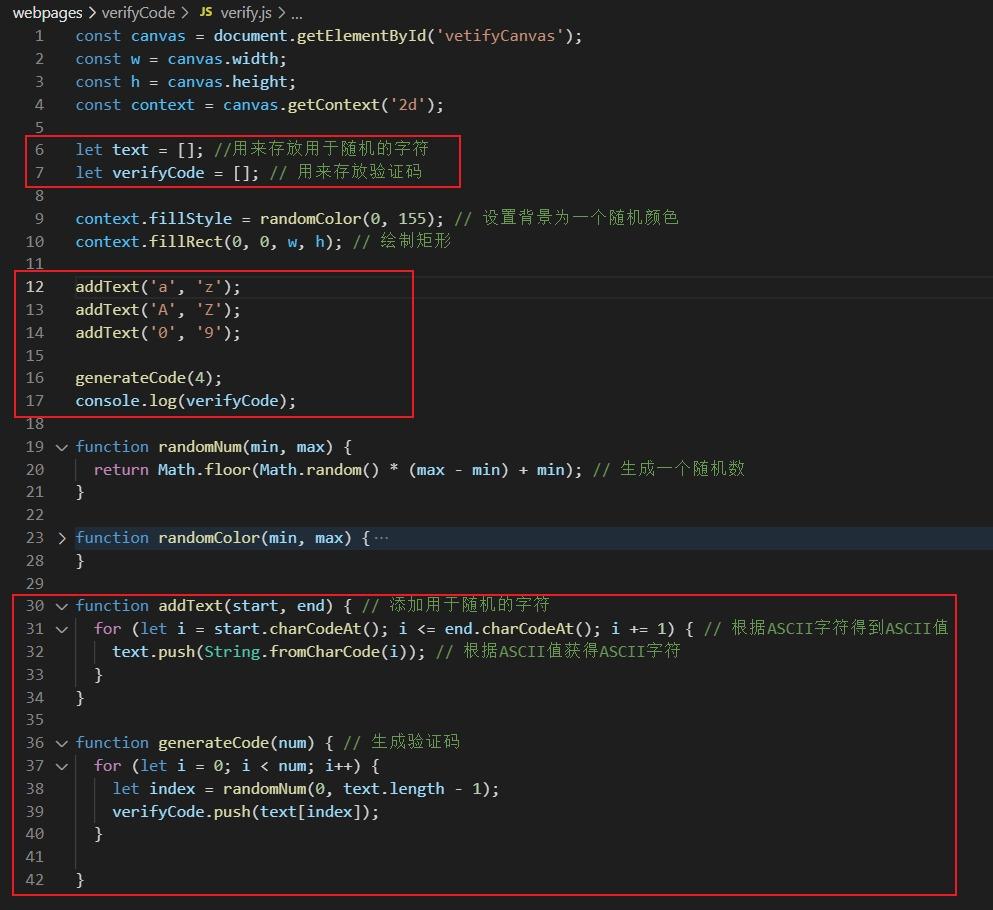
1.3 draw the generated verification code
const canvas = document.getElementById('vetifyCanvas');
const w = canvas.width;
const h = canvas.height;
const context = canvas.getContext('2d');
let text = []; //Used to store random characters
let verifyCode = []; // Used to store verification code
context.fillStyle = randomColor(0, 255); // Set the background to a random color
context.fillRect(0, 0, w, h); // draw rectangle
context.textBaseline = "middle";
addText('a', 'z');
addText('A', 'Z');
addText('0', '9');
generateCode(4);
function randomNum(min, max) {
return Math.floor(Math.random() * (max - min) + min); // Generate a random number
}
function randomColor(min, max) {
const r = randomNum(min, max);
const g = randomNum(min, max);
const b = randomNum(min, max);
return 'rgb(' + r + ', ' + g + ', ' + b + ')';
}
function addText(start, end) { // Add characters for random
for (let i = start.charCodeAt(); i <= end.charCodeAt(); i += 1) { // ASCII values are obtained from ASCII characters
text.push(String.fromCharCode(i)); // ASCII characters are obtained from ASCII values
}
}
function generateCode(num) { // Generate verification code
for (let i = 0; i < num; i++) {
let index = randomNum(0, text.length - 1);
verifyCode.push(text[index]);
let x = (w / 5) * i; // Used to control the coordinates to start writing
let y = h / 2;
context.font = randomNum(h / 2, h) + 'px SimHei'; // Randomly generated font size
context.fillStyle = randomColor(100, 200); // Randomly generated font color
context.translate(x, y); // Set coordinate origin
context.fillText(text[index], 0, 0); // write
context.translate(-x, -y); // Restore coordinate origin
}
}
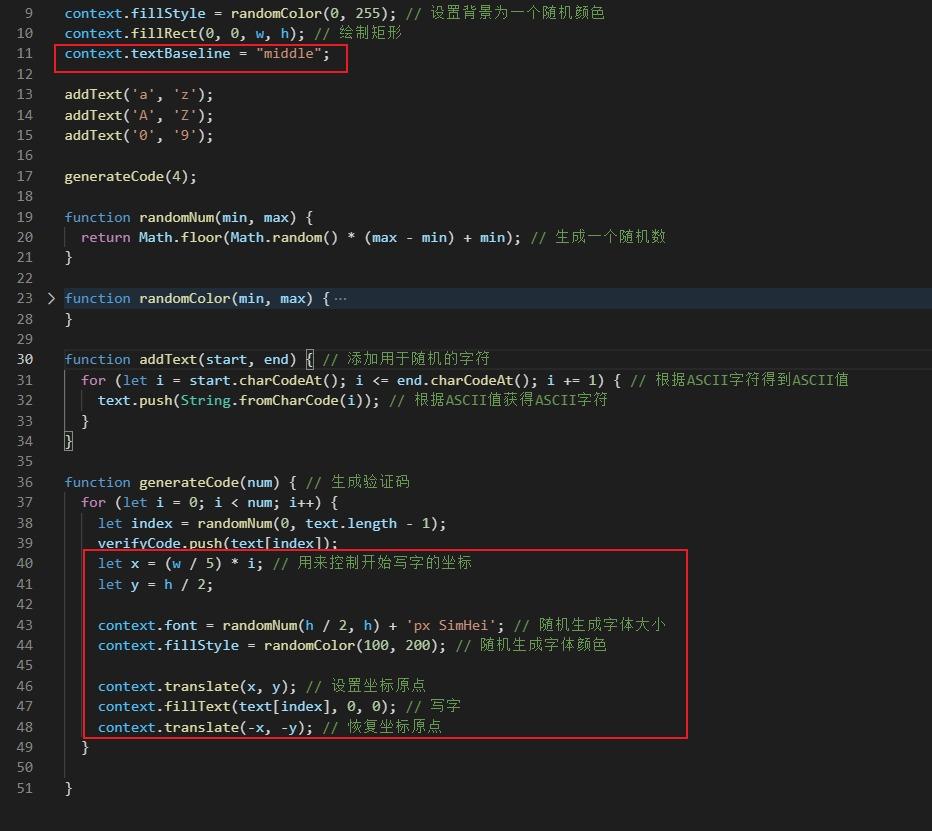
After writing, why restore the coordinate origin? After writing a word here, its coordinates will follow to the lower right corner, so if you don't return to the starting point, you will write an oblique line of words, and you can see the result by increasing the width and height of the canvas alone. Analysis may be wrong, please forgive me.
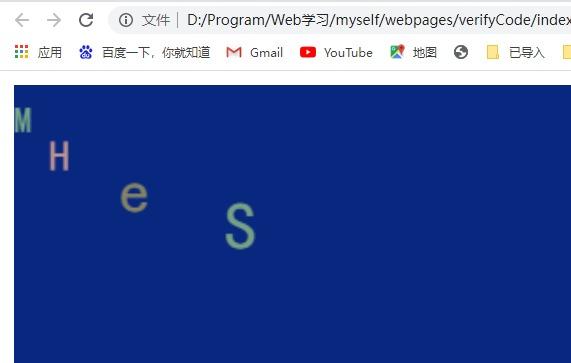
1.4 add special effects (text shadow and rotation)
const canvas = document.getElementById('vetifyCanvas');
const w = canvas.width;
const h = canvas.height;
const context = canvas.getContext('2d');
let text = []; //Used to store random characters
let verifyCode = []; // Used to store verification code
context.fillStyle = randomColor(0, 255); // Set the background to a random color
context.fillRect(0, 0, w, h); // draw rectangle
context.textBaseline = "middle";
addText('a', 'z');
addText('A', 'Z');
addText('0', '9');
generateCode(4);
function randomNum(min, max) {
return Math.floor(Math.random() * (max - min) + min); // Generate a random number
}
function randomColor(min, max) {
const r = randomNum(min, max);
const g = randomNum(min, max);
const b = randomNum(min, max);
return 'rgb(' + r + ', ' + g + ', ' + b + ')';
}
function addText(start, end) { // Add characters for random
for (let i = start.charCodeAt(); i <= end.charCodeAt(); i += 1) { // ASCII values are obtained from ASCII characters
text.push(String.fromCharCode(i)); // Obtain ASCII characters from ASCII values
}
}
function generateCode(num) { // Generate verification code
for (let i = 0; i < num; i++) {
let index = randomNum(0, text.length - 1);
verifyCode.push(text[index]);
let x = (w / 5) * i; // Used to control the coordinates to start writing
let y = h / 2;
context.shadowOffsetX = randomNum(-3, 3);
context.shadowOffsetY = randomNum(-3, 3);
context.shadowBlur = randomNum(-3, 3);
context.shadowColor = 'rgba(0, 0, 0, 0.3)';
context.font = randomNum(h / 2, h) + 'px SimHei'; // Randomly generated font size
context.fillStyle = randomColor(100, 200); // Randomly generated font color
const deg = randomNum(-20, 20);
context.translate(x, y); // Set coordinate origin and rotation angle
context.rotate(deg * Math.PI / 180);
context.fillText(text[index], 0, 0); // write
context.translate(-x, -y); // Restore coordinate origin and rotation angle
context.rotate(-deg * Math.PI / 180);
}
}
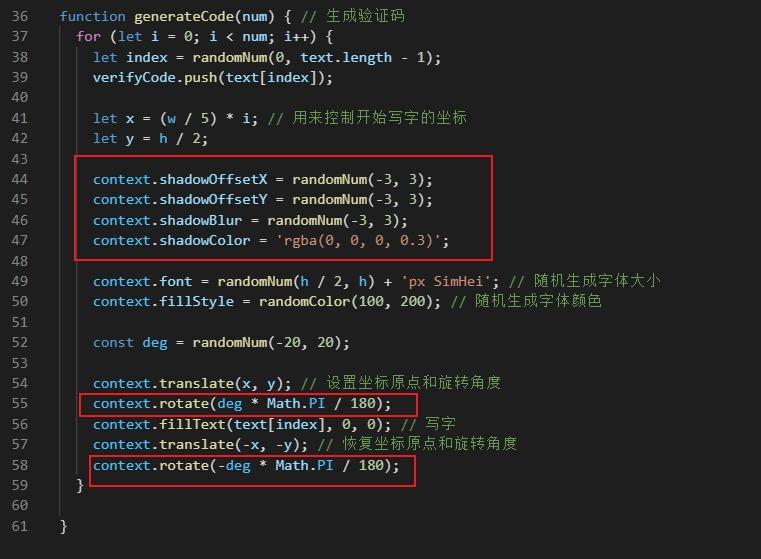
1.5 add interference lines and interference points
const canvas = document.getElementById('vetifyCanvas');
const w = canvas.width;
const h = canvas.height;
const context = canvas.getContext('2d');
let text = []; //Used to store random characters
let verifyCode = []; // Used to store verification code
context.fillStyle = randomColor(0, 255); // Set the background to a random color
context.fillRect(0, 0, w, h); // draw rectangle
context.textBaseline = "middle";
addText('a', 'z');
addText('A', 'Z');
addText('0', '9');
generateCode(4);
ganrao();
function randomNum(min, max) {
return Math.floor(Math.random() * (max - min) + min); // Generate a random number
}
function randomColor(min, max) {
const r = randomNum(min, max);
const g = randomNum(min, max);
const b = randomNum(min, max);
return 'rgb(' + r + ', ' + g + ', ' + b + ')';
}
function addText(start, end) { // Add characters for random
for (let i = start.charCodeAt(); i <= end.charCodeAt(); i += 1) { // ASCII values are obtained from ASCII characters
text.push(String.fromCharCode(i)); // ASCII characters are obtained from ASCII values
}
}
function generateCode(num) { // Generate verification code
for (let i = 0; i < num; i++) {
let index = randomNum(0, text.length - 1);
verifyCode.push(text[index]);
let x = (w / 5) * i; // Used to control the coordinates to start writing
let y = h / 2;
context.shadowOffsetX = randomNum(-3, 3);
context.shadowOffsetY = randomNum(-3, 3);
context.shadowBlur = randomNum(-3, 3);
context.shadowColor = 'rgba(0, 0, 0, 0.3)';
context.font = randomNum(h / 2, h) + 'px SimHei'; // Randomly generated font size
context.fillStyle = randomColor(100, 200); // Randomly generated font color
const deg = randomNum(-20, 20);
context.translate(x, y); // Set coordinate origin and rotation angle
context.rotate(deg * Math.PI / 180);
context.fillText(text[index], 0, 0); // write
context.translate(-x, -y); // Restore coordinate origin and rotation angle
context.rotate(-deg * Math.PI / 180);
}
}
function ganrao() {
// Draw interference line
// for (var i = 0; i < 4; i++) {
// context.strokeStyle = randomColor(40, 180);
// context.beginPath();
// context.moveTo(randomNum(0, w), randomNum(0, h));
// context.lineTo(randomNum(0, w), randomNum(0, h));
// context.stroke();
// }
// Draw interference points
for (var i = 0; i < w / 4; i++) {
context.fillStyle = randomColor(0, 255);
context.beginPath();
context.arc(randomNum(0, w), randomNum(0, h), 1, 0, 2 * Math.PI);
context.fill();
}
}
effect:
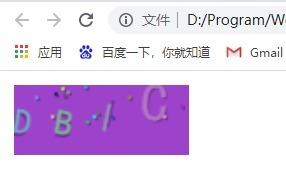
1.6 add the function of refreshing by clicking
Context save(); And context restore(); To achieve the effect of emptying the canvas and redrawing
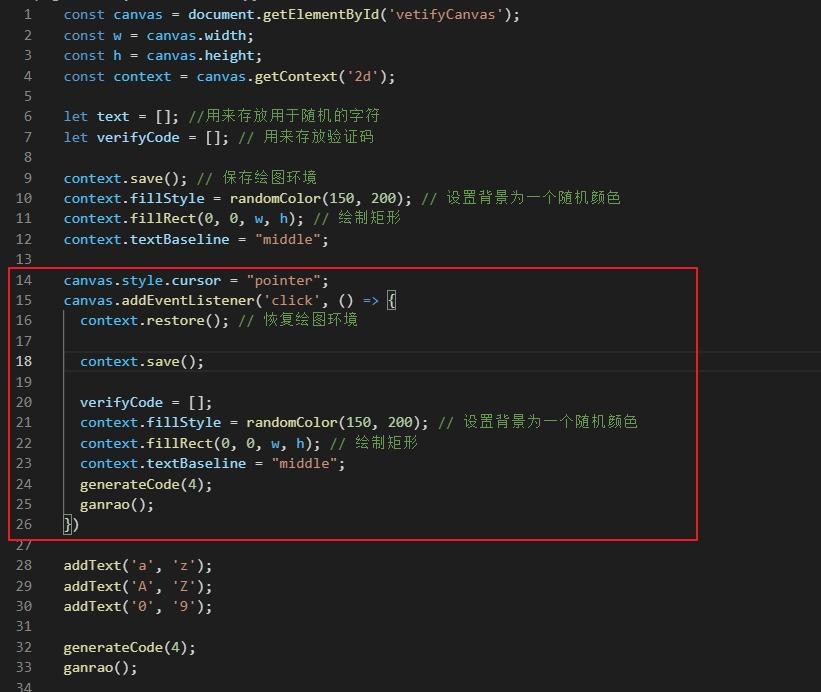
Full code: Verification code (codepen.io)
2. Generate 32-bit random code
During the project meeting, I heard that the id in the data table should use the general method of generating 32-bit random code instead of int + self increment. I want to try to generate 32-bit random code by myself.
First, you need to get an array of characters used to generate random codes. Here, you can use hand tapping, but it's too tired. You can also use the method when generating the verification code. Because the characters of js cannot be self incremented, you can use the charCodeAt() function to convert the characters into ASCII values, and then perform the self incrementing operation. Of course, the values obtained in each traversal are ASCII values, so you can use string The fromcharcode() function converts ASCII values into ASCII characters.
The specific implementation is as follows:
function getContent(start, end) {
let arr = [];
for (let i = start.charCodeAt(); i <= end.charCodeAt(); i++) {
arr.push(String.fromCharCode(i));
}
return arr;
}
After the characters used to generate random codes are obtained, 32-bit random codes can be generated directly through the random function random().
function getRandom() {
let arr = [];
arr = arr.concat(getContent('a', 'z'));
arr = arr.concat(getContent('0', '9'));
let id = '';
for (let i = 0; i < 32; i++) {
id += arr[parseInt(Math.random() * 36)];
}
console.log(id);
}
function getContent(start, end) {
let arr = [];
for (let i = start.charCodeAt(); i <= end.charCodeAt(); i++) {
arr.push(String.fromCharCode(i));
}
return arr;
}
getRandom();
The complete implementation is as follows:
function getRandom() {
let arr = [];
arr = arr.concat(getContent('a', 'z'));
arr = arr.concat(getContent('0', '9'));
let id = '';
for (let i = 0; i < 32; i++) {
id += arr[parseInt(Math.random() * 36)];
}
console.log(id);
}
function getContent(start, end) {
let arr = [];
for (let i = start.charCodeAt(); i <= end.charCodeAt(); i++) {
arr.push(String.fromCharCode(i));
}
return arr;
}
getRandom();
Possible common method: record it. There may be better methods to update after discovery.
function getContent(start, end) {
let arr = [];
for (let i = start.charCodeAt(); i <= end.charCodeAt(); i++) {
arr.push(String.fromCharCode(i));
}
return arr;
}
Original address (personal blog): JavaScript in development (I) -- red, blue and purple
Reference link: JS realizes the function of picture verification code - user input verification code - vickylinj - blog Garden (cnblogs.com)